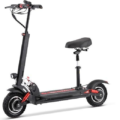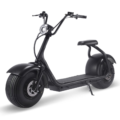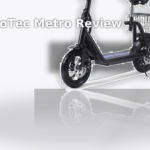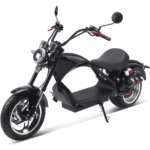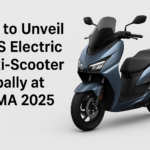- Home
- Scooters
- Electric Scooters
- MotoTec Ares
MotoTec Ares
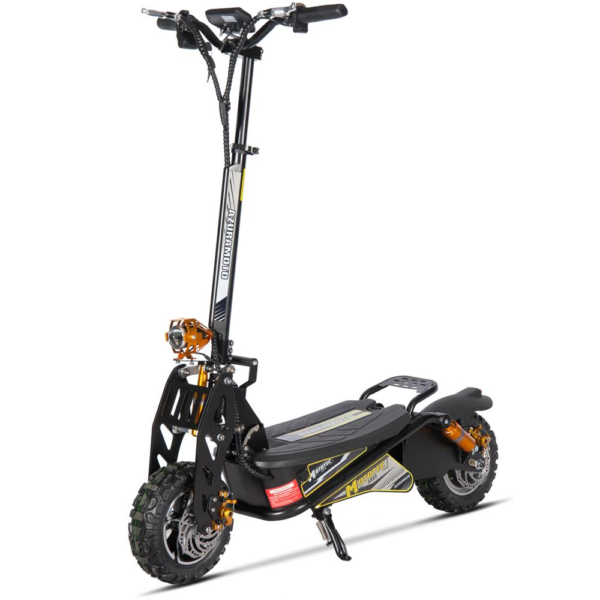

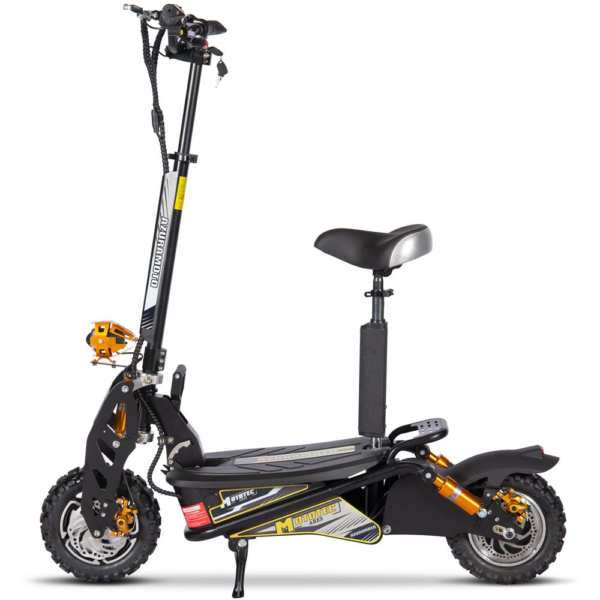
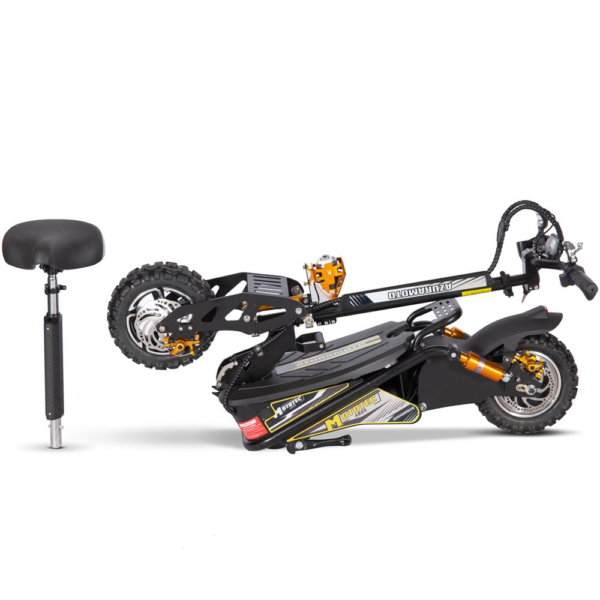
- Battery Range: 10–20 miles (16–32 km)
- Top Speed: 30 mph (48 km/h)
- Motor Power: 1600 W
- Weight Capacity: 265 lb (120.2 kg)
- Charging Time: ~4–6 h
- Scooter Weight: 113.0 lb (51.3 kg)
PROS
- 1600 W motor with LCD display
- 30 mph (48 km/h) top speed
- Front & rear suspension with knobby tires
- Removable seat and folding frame
- Economy mode button
CONS
- Lower 265 lb (120.2 kg) max rider weight
- Lead-acid battery pack
- No official IP rating
- Shorter 10–20 mi (16–32 km) range
Key Takeaways
- The MotoTec Ares is a rugged, foldable electric scooter designed for mixed surfaces, featuring a powerful 1,600-watt rear motor.
- It includes a removable seat, spacious deck, and strong suspension for stability and comfort during rides.
- With a top speed of 30 mph and a range of 10–20 miles, the Ares suits daily commutes and rougher terrains.
- Key features include simple controls, effective braking, and a user-friendly design for maintenance and service.
- The Ares works best for larger riders or those needing stability, but it’s not ideal for frequent carrying or long-range needs.
Table of contents
- What Is the MotoTec Ares?
- How the MotoTec Ares Works
- Key Specifications
- Design & Build Quality
- Performance Fundamentals
- Battery, Range & Efficiency
- Ride Quality & Comfort
- Braking & Safety Features
- Portability & Daily Usability
- Maintenance & Care
- Weather & Seasonal Considerations
- MotoTec Ares vs Alternatives
- Who the MotoTec Ares Is (and Isn’t) For
- FAQs
- Glossary
The MotoTec Ares is a rugged stand-up scooter with a removable seat and a stout steel frame. It runs a 48-volt system and a 1,600-watt rear motor that pulls hard off the line and cruises with ease. So it suits riders who want simple controls, real suspension, and chunky tires for mixed surfaces. We stick to the official specifications and plain, test-style notes.
If you want a sturdy commuter that handles rough patches and short dirt paths, the MotoTec Ares fits well. It trades light weight for stability, range, and comfort. And it feels built to be used, not babied.
What Is the MotoTec Ares?
The MotoTec Ares is a foldable electric scooter made for daily rides on hard surfaces with the option to hop onto firm dirt. It ships with a quick-release seat, a tall stem, and a large deck with grippy plates. The motor sits at the rear and draws power from a 48-volt battery pack made from four 12-volt SLA bricks. You get front and rear disc brakes, spring suspension at both ends, and knobby 90/65-6.5 tires.
Next, check the cockpit. The layout is simple and easy to learn. A twist throttle sits on the right grip. An LCD shows speed, battery bars, and trip data. A headlight and tail/stop light come built in. And there’s an Eco button that softens demand to stretch range. The rated load is 265 lb, so larger adults ride without stressing the frame. If you’re browsing for a true starter model for small kids, take a quick look at the Hover-1 My First E-Scooter—it sits in a different class, yet it helps set expectations for new riders.
How the MotoTec Ares Works
The Ares follows a straightforward layout, and that helps with both riding and upkeep.
- First, the motor. A rear brushless DC unit rated at 1,600 W does the work. It delivers strong low-end torque, so launches feel brisk, and rolling hills feel manageable.
- Next, the controller. A 48-volt controller meters current to the motor and handles the Eco mode. It smooths the throttle signal and guards the pack from over-current and under-voltage.
- Then, the battery. The pack uses four sealed lead-acid batteries wired in series for 48 V nominal. Total capacity is 12 Ah, which comes to about 576 Wh of stored energy.
- After that, the throttle. A right-hand twist grip sends a variable signal. You can creep in tight spaces, then roll on more power for ramps and merges.
- Finally, the brakes. Cable discs front and rear provide firm bite. Lever feel is predictable, and you can tune cable tension with inline adjusters.
So the ride feels familiar if you’ve used twist-throttle gear. Then service stays simple since the parts are common and easy to reach.
Key Specifications
We pulled these from the maker’s published data. Conversions appear in metric. This is where the specifications live in one place.
| Block | Item | Value |
|---|---|---|
| General | Model | MotoTec Ares |
| Frame | High-tensile steel | |
| Display | LCD speedometer with battery and odometer | |
| Headlight / Taillight | Front LED / Rear LED | |
| Performance & Power | Motor | 1,600 W brushless DC, rear drive |
| Top speed | Up to 30 mph (≈ 48 km/h) | |
| Max grade | About 10% (firm surfaces) | |
| Rider weight limit | 265 lb (≈ 120 kg) | |
| Battery, Charging & Electrical | Battery | 48 V, four 12 V / 12 Ah sealed lead-acid (SLA) |
| Energy (derived) | ≈ 576 Wh (48 V × 12 Ah) | |
| Charger output | 57.6 V DC, ≈ 86 W, ≈ 1.5 A | |
| Charge time | 4–6 hours typical; some manuals state ≈10–12 hours with a 1.5 A charger | |
| Eco mode | Yes, reduces power draw | |
| Build & Dimensions | Tires | 90/65-6.5 knobby |
| Suspension | Single front shock, dual rear shocks | |
| Brakes | Front and rear disc | |
| Ground clearance | 3 in (≈ 7.6 cm) | |
| Wheelbase | 37 in (≈ 94 cm) | |
| Scooter size (unfolded) | 50 × 26 × 49 in (≈ 127 × 66 × 124 cm) | |
| Folded size (manual) | 123 × 29 × 49 cm (≈ 48.4 × 11.4 × 19.3 in) | |
| Scooter weight | 113 lb (≈ 51 kg) | |
| Safety & Control | Lighting | Front LED, rear LED with brake |
| IP rating | IP54 splash resistant | |
| Features & Extras | Seat | Removable seat and post included |
| Folding | Yes, latch at deck | |
| Cruise Control | Not available | |
| Warranty & Compliance | Warranty | 60 days parts replacement |
| Compliance | CE, RoHS |
Design & Build Quality
From the first touch, the Ares feels stout. The deck is wide with open lattice plates that drain water and add grip. The steel frame resists twist, and the welds look uniform. So the folding joint sits low in the chassis, and the stem slots into a solid base plate. That helps reduce wobble at speed.
Then look at the stem. It rises tall and gives a roomy reach to the bars. The clamp stack uses standard bolts you can snug at home. The cockpit keeps the essentials in a tight cluster. You get a twist throttle, dual brake levers, a light switch, and the Eco button. The LCD is clear in shade, and it stays readable under bright sun if you tilt it a touch to cut glare.
The seat kit drops into a tube on the deck and locks with a clamp. It sits around 30 in (≈76 cm) at the top of the post, which suits many riders. So you can ride standing with plenty of deck space, then sit when your legs need a break. Cables run along the stem with tidy clips. Fasteners use common sizes, so a basic metric hex set keeps everything snug.
Performance Fundamentals
The first few feet set the tone. The MotoTec Ares pulls cleanly from a stop, and the rear drive holds traction as weight shifts back. In city traffic, the scooter reaches neighborhood speeds in a short block. Then it keeps a steady pace on flat ground.
On rolling streets, the motor holds speed with a light dip near the crest. On 7–10% grades, expect speed to fall in the middle, then recover as you reach the top. A hill start on a moderate grade needs a firm twist and a steady stance. So the chassis stays composed if you keep your weight low over the deck.
At cruising pace, the long wheelbase helps with straight-line stability. The tall stem flexes a touch on rough patches, yet the deck stays quiet, and the steering feels calm. Meanwhile, the knobby 90/65-6.5 tires track well on firm dirt and old asphalt. On brand-new pavement, they hum a bit. That’s normal for this tread.
Battery, Range & Efficiency
Range swings, and the pack size tells you why. The Ares stores about 576 Wh. That is a fair amount for mixed rides, and it pairs well with the 48-volt drive. On flat routes with a 175 lb rider, steady throttle, and Eco on in busy zones, you can finish 12–18 miles (≈19–29 km) without stress. On colder days, range falls. So does long high-speed riding.
Next, think about factors that move the number. Weight, wind, hills, and tire pressure all play a part. A heavier rider who holds near top speed lands near the low end of the 10–20 mile (≈16–32 km) envelope. By contrast, a lighter rider who cruises around 18–22 mph (≈29–35 km/h) and keeps Eco on in slow areas can stretch it.
Lead-acid packs like full charges and regular use. So top the pack after each ride, and don’t store it empty. If the scooter will sit for a few weeks, give it a full charge once a month. Keep the pack near room temperature. Then voltage sag stays lower near the end of a ride, and capacity fade slows.
Ride Quality & Comfort
Ride feel comes from three parts: tires, suspension, and stance. The Ares runs knobby 90/65-6.5 tires that float over cracks and grip loose grit better than slicks. The front spring and the dual rear springs take the edge off sharp bumps. You still feel big potholes, so slow down when streets get rough.
Standing, the deck gives you room to change foot position. Square up for traction off the line, then switch to a staggered stance for corners and long runs. The stem has a tall rise, and that takes strain off your back on longer rides. At speed, the front end stays light and easy to place. On braking, the deck stays level if you set your hips low before you squeeze the levers.
Seated rides feel calm on straight roads. The post height works for short commutes and errands. On choppy surfaces, stand up over bumps to spare the seat and your spine. Then sit again on smooth sections to rest.
Braking & Safety Features
Braking is where the Ares feels friendly. The discs bite early, then build power in a smooth way. Squeeze with two fingers for speed trims, and pull deeper for hard stops. You can balance front and rear to keep the chassis stable. The levers have adjusters, so you can set cable tension and lever throw to your preference.
The lights help you stay seen. The front LED casts a white beam for dusk rides, and the rear light brightens when you brake. For extra side visibility, add reflective tape on the deck edges. The frame and deck sit high enough to clear curbs, and the IP54 rating guards against dust and road splash. So avoid deep puddles, and dry the scooter after wet rides.
Portability & Daily Usability
This is a heavy scooter at about 113 lb (≈51 kg). So plan around that weight. The folding latch is simple, and the stem folds down toward the deck. When folded, the package measures about 48.4 × 11.4 × 19.3 in (≈123 × 29 × 49 cm). That shape fits in many trunks with the seat removed, and it slides under a workbench for storage.
Carry the scooter only for short steps. Instead, roll it whenever you can. Use a strong lock through the frame plate around a fixed rack, and back it up with a thick chain on the rear wheel. Remove the seat post if you park outside for long stretches. Then keep the charger at home or work, and top up during the day if you plan a long loop home.
Maintenance & Care
A simple routine keeps the Ares sharp.
- Before each ride: Check tire pressure. Aim near the sidewall rating and adjust for comfort. Then squeeze both levers to confirm firm bite.
- Weekly: Inspect stem bolts, caliper bolts, axle nuts, and deck fasteners. Tighten to snug, not stripped. Next, spin wheels to confirm no rub.
- Monthly: Charge the pack fully. Check cable fray near the levers. Add a small drop of light oil on brake pivot points.
- Every 3 months: Inspect pads and rotors. Pads should show even wear and decent thickness. If you feel pulsing at the lever, true the rotor.
- Storage: Park indoors, cool and dry. Charge to full before any long sit. Then top up once a month to protect the pack.
Replace wear parts early. Fresh pads and tight cables make a big difference in control. And keep a small tool roll with 4, 5, and 6 mm hex keys, plus a Phillips driver.
Weather & Seasonal Considerations
Rain and cold change how the scooter rides. The IP54 rating helps with splash, yet long rain and standing water are not your friend. In the wet, knobby tires grip well in a straight line, but paint lines and metal plates get slick. So slow down and brake in a straight path.
Heat can shorten battery life. Park in the shade and let the pack cool before charging. Cold air thickens grease and drops voltage under load. So expect reduced range when the temperature dips. Pump the tires near the upper range in winter to cut rolling drag, and check pressure more often.
In all seasons, brush grit off the chain cover, calipers, and deck plates. Then dry the scooter. Corrosion starts fast on wet hardware. A quick wipe goes a long way.
MotoTec Ares vs Alternatives
Scooters in this weight class fall into three broad groups: simple commuters, mixed-surface builds like the Ares, and high-power off-road machines. Paper specifications help, yet ride feel matters more once you leave the driveway.
The Ares shines when streets are broken and your route includes rough side roads. The long wheelbase and dual shocks calm small hits. The knobby tires hold on gravel shoulders and old chip seal. And the removable seat adds comfort on long flat stretches.
A light commuter trades stability for easy lifting and quick folding. That style slips into trains with less effort and fits under smaller desks. It often uses narrow slick tires and a shorter stem, so the ride feels quicker but less planted.
A pure off-road scooter adds higher voltage, beefier suspension links, and bigger batteries. Weight and cost rise fast. That style fits steep tracks and long dirt climbs, yet it can be overkill for daily city use.
So pick the Ares if you want a sturdy build that shrugs off rough pavement and short dirt links. Choose a lighter commuter if you carry your scooter often. If you want something in the same family with a different feel for play and mixed terrain, the MotoTec Free Ride is another route worth checking out.
Who the MotoTec Ares Is (and Isn’t) For
Great for:
- Daily rides on mixed pavement with cracks, patches, and gravel shoulders.
- Bigger riders who want a high load rating and a stable deck.
- Short to medium commutes where a removable seat helps on long straight sections.
- Owners who prefer simple service with common parts.
Not ideal for:
- Walk-up apartment dwellers who must carry a scooter often.
- Train commuters with tight car doors and narrow aisles.
- Riders who need 25+ mile (≈40+ km) range every day without a mid-day charge.
FAQs
How fast does the MotoTec Ares go?
It can reach up to 30 mph (≈48 km/h) on level ground with one rider.
What is the real-world range?
Plan for 10–20 miles (≈16–32 km) based on rider weight, speed, wind, and terrain. So stay near the low end at high speeds or in cold weather.
What does the Eco button do?
It reduces peak power draw. Then acceleration softens, and range improves.
Does it have cruise control?
No. The Ares uses a twist throttle without a cruise hold.
Is the MotoTec Ares water resistant?
Yes. It carries an IP54 rating for dust and splash. So avoid deep puddles and pressure washing.
How long does charging take?
Many listings say about 4–6 hours. The charger spec is 57.6 V at about 1.5 A, which points closer to 10–12 hours with that unit. Real time depends on charger output and battery state.
Where can I find a “MotoTec Ares overview” in one place?
You’re reading it here. This guide covers design, power, range, comfort, and care.
Glossary
- Ah (amp-hours): A measure of battery capacity. Higher numbers store more charge.
- Wh (watt-hours): Energy content. Multiply volts by amp-hours to estimate stored energy.
- Brushless motor: Electric motor with electronic commutation for high efficiency and low maintenance.
- Controller: The box that manages power flow from the battery to the motor.
- Eco mode: A setting that limits power to extend range.
- Disc brake: A caliper squeezes pads on a metal rotor attached to the wheel.
- Regen: Electronic braking that puts energy back into the pack. The Ares uses mechanical discs and doesn’t advertise regen.
- Stem flex: The small bend you feel at the handlebar under load.
- IP rating: Ingress Protection. IP54 means limited dust entry and splash resistance.
- Voltage sag: A drop in voltage under heavy load or low charge.
- Wheelbase: Distance between front and rear wheel centers.
- Ground clearance: Distance from the deck base to the road.
- Nominal voltage: The standard operating voltage for a battery pack.
- Lead-acid (SLA): Sealed battery type with low cost and simple care.
- Torque: Turning force from the motor that you feel as pull.
Specifications
General
| Model The Model specifies the exact version or name of the scooter. It helps identify its unique design, features, and specifications within the manufacturer’s product line. Knowing the model makes it easier to compare options, find compatible accessories, or look up support information. | Ares |
| Brand The Brand identifies the manufacturer or company that designs and produces the scooter. A trusted brand is a sign of quality, reliability, and good customer support. Well-known brands often have higher standards for safety, performance, and after-sales service, giving you more confidence in your purchase. | MotoTec |
| Release Date The Release Date indicates when the scooter model was officially launched on the market. This helps you know how current the design, technology, and features are. A newer release date often means updated components, improved performance, and the latest safety or smart features. | 18 November 2025 |
| Recommended Age Recommended Age indicates the minimum age range that the scooter is designed for, based on safety, size, and ease of use. Following the recommended age helps ensure that riders can handle the scooter’s speed, weight, and controls comfortably and safely. Always check local laws and use protective gear, especially for younger riders. | 13+ |
Performance & Power
| Motor Power (Wattage) What it means: The motor power, measured in watts (W), shows how strong the scooter’s electric motor is. Why it matters: Higher wattage usually means better acceleration, more torque, and improved performance on hills or rough terrain. For example, a 250W motor is good for flat city roads and light riders, while a 500W or 1000W motor provides more power for faster speeds or climbing steep inclines. | Brushless motor, 1600 W (48 V) |
| Top Speed The Top Speed indicates the maximum speed that the scooter can reach under optimal conditions. It’s usually measured on level ground with a fully charged battery and an average rider weight. A higher top speed allows you to travel longer distances faster, but always ensure you ride within legal speed limits and your personal comfort zone for safety. | 30 mph (48 km/h) |
| Battery Capacity Battery Capacity refers to the total amount of energy the scooter’s battery can store, usually measured in ampere-hours (Ah) or watt-hours (Wh). A higher battery capacity means you can ride longer distances on a single charge, reducing the need for frequent recharging. Keep in mind that actual range can vary depending on rider weight, terrain, speed, and weather conditions. | 48 V 12 Ah (576 Wh) Lead-acid (4×12 V 12 Ah) |
| Estimated Range per Charge The Estimated Range per Charge indicates the average distance the scooter can travel on a single full battery charge. This range is calculated under optimal conditions, such as flat terrain, moderate speed, and average rider weight. Real-world range may vary depending on riding style, terrain, weather, and load. A longer range means fewer recharges and greater freedom for longer trips. | 10–20 miles (16–32 km) |
| Hill Climb Ability Hill Climb Ability describes the maximum incline or slope that the scooter can handle while maintaining stable performance. It’s typically expressed as a percentage or in degrees. A higher hill climb rating means the scooter can tackle steeper hills without losing too much speed or power. Actual climbing performance may vary based on rider weight, battery charge, and terrain conditions. | Not specified |
| Drive System The Drive System refers to how power from the motor is delivered to the wheels. Electric scooters typically use either a hub motor (directly integrated into the wheel) or a chain/belt drive system. A high-quality drive system ensures smooth acceleration, efficient power transfer, and low maintenance. The choice of drive system affects performance, noise level, and overall ride experience. | RWD (drive type not specified) |
Charging & Electrical
| Charging Time Charging Time indicates how long it takes to fully recharge the scooter’s battery from empty to 100% using the standard charger provided. Faster charging means less downtime and more time on the road. Actual charging time may vary slightly depending on battery capacity, charger output, and environmental conditions. | Approx. 4–6 hours |
| Battery Type Battery Type refers to the specific technology used in the scooter’s battery, which affects performance, lifespan, weight, and charging time. Most modern electric scooters use high-quality lithium-ion (Li-ion) batteries because they offer a good balance of energy density, durability, and low maintenance. A reliable battery type ensures consistent power delivery and longer riding ranges. | Sealed lead-acid battery |
| Removable Battery A Removable Battery means the battery pack can be easily detached from the scooter for convenient charging and replacement. This feature allows you to charge the battery separately, swap it with a spare for extended range, or securely store it indoors in extreme weather. Removable batteries add flexibility and make it easier to keep your scooter powered up wherever you are. | Non-removable internal battery |
| Regenerative Braking Regenerative Braking is an energy-saving feature that converts some of the energy normally lost during braking back into battery power. When you slow down or brake, the motor works in reverse to generate electricity, which helps extend the scooter’s range and improves overall efficiency. This system also reduces wear on traditional brake components, leading to lower maintenance over time. | No |
| Lighting Lighting refers to the built-in front and rear lights that enhance visibility and safety when riding in low-light conditions or at night. Good lighting helps you see the road ahead and ensures that other road users can see you. Many scooters include LED headlights, taillights, and sometimes brake lights or side reflectors for added safety and compliance with local traffic regulations. | LED headlight; rear light; LCD screen backlight |
Build & Dimensions
| Scooter Weight Scooter Weight refers to the total weight of the scooter when fully assembled, including the battery. This affects how easy it is to carry, lift, and store the scooter when not in use. A lighter scooter is more portable and convenient for commuting, especially if you need to carry it upstairs or onto public transport. Keep in mind that a sturdy frame and quality components may add to the weight but also contribute to better durability and ride stability. | 113.0 lb (51.3 kg) |
| Maximum Rider Weight Maximum Rider Weight indicates the highest rider weight that the scooter is designed to safely support while maintaining optimal performance and stability. Staying within this limit helps ensure reliable acceleration, braking, and climbing ability, and it protects the frame, suspension, and motor from excessive strain. Exceeding the recommended limit may reduce performance and increase wear on components. | 265 lb (120.2 kg) |
| Deck Size Deck Size refers to the dimensions of the scooter’s standing platform. A wider and longer deck provides more foot space, allowing you to stand comfortably and adjust your stance while riding. A well-sized deck improves balance and stability, especially on longer rides or at higher speeds. Compact decks, on the other hand, help keep the scooter lightweight and portable. | Seated scooter; modern frame with LCD |
| Handlebar Height Handlebar Height refers to the distance from the deck to the handlebars, which affects your riding posture and comfort. An appropriate handlebar height helps you maintain good balance, reduces strain on your back and arms, and makes steering more comfortable. Some scooters have adjustable handlebars to fit riders of different heights, while others have a fixed height for a streamlined design. | Not specified |
| Folding Mechanism The Folding Mechanism describes how easily and securely the scooter can be folded for carrying and storage. A well-designed folding system lets you quickly collapse the scooter into a compact size, making it convenient to transport on public transit, store under a desk, or fit into a car trunk. Look for sturdy latches and safety locks to ensure the scooter stays firmly in place when folded or unfolded. | Folding frame; removable seat |
| Dimensions Folded Dimensions indicate the size of the scooter when it’s fully folded. This measurement shows how much space the scooter will take up when stored or carried, making it easier to check if it will fit in your car trunk, under a desk, or in a closet. Compact folded dimensions are ideal for commuters who need to bring their scooter on public transport or store it in tight spaces. | Unfolded: 50 × 26 × 49 in (127 × 66 × 124 cm); folded: Not specified |
| Material Material refers to the primary construction materials used for the scooter’s frame and key components. High-quality materials like aircraft-grade aluminum, reinforced steel, or durable composites provide strength, stability, and a lighter overall weight. A sturdy material ensures the scooter can handle daily wear and tear while maintaining safety and performance. | High-tensile steel |
Safety & Control
| Brake Type(s) Brake Type(s) describe the braking systems the scooter uses to help you slow down or stop safely. Common brake types include mechanical brakes (like drum or disc brakes), electronic brakes, and foot brakes. Many scooters combine multiple braking systems for added safety and shorter stopping distances. The type and quality of brakes affect your control, especially when riding at higher speeds or on slopes. | Front & rear disc brakes |
| Suspension Suspension refers to the system that absorbs shocks and vibrations while riding, providing a smoother and more comfortable ride over uneven or rough surfaces. Scooters may have front suspension, rear suspension, or dual suspension for better shock absorption and stability. Good suspension helps reduce rider fatigue and improves control, especially when riding on bumpy roads or off-road paths. | Front & rear suspension (type not specified) |
| Tire Type Tire Type refers to the kind of tires the scooter uses, which directly affects ride comfort, traction, and maintenance. Common types include solid (airless) tires, pneumatic (air-filled) tires, or hybrid options. Pneumatic tires offer better shock absorption and a smoother ride on rough surfaces, while solid tires are puncture-proof and require less upkeep. The right tire type helps ensure safe handling and a comfortable ride in different conditions. | 90/65-6.5 knobby tires |
| Tire Size Tire Size indicates the diameter and width of the scooter’s tires, which affect ride comfort, stability, and how well the scooter handles different terrains. Larger tires generally offer better shock absorption and a smoother ride over bumps and rough surfaces, while smaller tires keep the scooter lighter and more portable. Choosing the right tire size helps ensure a balance between agility and comfort. | 6.5-inch rim |
| Kickstand The Kickstand is a built-in stand that allows you to park your scooter upright when it’s not in use. A sturdy kickstand keeps the scooter stable and prevents it from tipping over, protecting it from scratches and damage. It also makes storing and accessing your scooter more convenient, whether you’re at home, work, or on the go. | Side kickstand |
| Water Resistance Rating Water Resistance Rating indicates how well the scooter is protected against water and moisture, usually shown as an IP (Ingress Protection) rating. This rating helps you understand whether the scooter can handle light rain, splashes, or wet roads without damage. While most scooters are not fully waterproof, a good water resistance rating adds peace of mind when riding in changing weather conditions. Always avoid deep puddles or submerging the scooter to protect its electrical components. | Not specified |
Features & Extras
| Display/Console The Display (or Console) shows important real-time information about your ride, helping you monitor your scooter’s status at a glance. Typical displays show speed, battery level, distance traveled, and riding mode. Some models also include additional features like Bluetooth connectivity, app integration, or backlighting for better visibility at night. A clear and easy-to-read display enhances safety and convenience on every trip. | LCD display (speed, battery) |
| Ride Modes Ride Modes refer to the different speed and power settings you can choose to match your riding style or road conditions. Common modes include eco for maximum range and energy efficiency, standard for everyday balance, and sport or turbo for higher speed and stronger acceleration. Switching between ride modes allows you to customize performance, conserve battery, and ride safely in various environments. | Economy mode toggle |
| Smart App Connectivity Smart App Connectivity lets you pair your scooter with a dedicated mobile app via Bluetooth. Using the app, you can monitor real-time ride stats like speed, battery level, and range, adjust settings such as ride modes or cruise control, lock the scooter for added security, and sometimes receive firmware updates. This feature adds convenience and allows you to personalize your riding experience right from your smartphone. | No app |
| Anti-Theft System The Anti-Theft System helps protect your scooter from unauthorized use or theft. This feature can include built-in alarms, electronic motor locks, GPS tracking, or remote locking through a mobile app. A good anti-theft system provides peace of mind when parking your scooter in public spaces, adding an extra layer of security to safeguard your investment. | None stated |
| Cruise Control Cruise Control allows you to maintain a steady speed without continuously holding the throttle. This feature makes longer rides more comfortable by reducing hand fatigue and providing a smoother, more relaxed riding experience — especially on flat, open roads or bike lanes. For safety, cruise control can usually be easily activated or deactivated while riding. | No |
| Accessories Included Accessories Included lists the additional items that come with the scooter to enhance your riding experience and convenience. Common accessories may include a charger, kickstand, bell, lights, phone holder, or carrying strap. These extras add value by making your scooter safer, easier to use, and ready to ride straight out of the box. | Scooter, charger (48 V ~1.5 A), tools, manual |
Warranty & Compliance
| Warranty Period The Warranty Period indicates how long the manufacturer guarantees the scooter against defects in materials and workmanship under normal use. A good warranty provides peace of mind, showing the brand’s confidence in its product quality. Always check what parts are covered, such as the frame, battery, and motor, and follow the maintenance guidelines to keep your warranty valid. | 60 days parts replacement (USA) |
| Certifications Certifications confirm that the scooter meets specific safety, quality, and environmental standards set by recognized organizations or regulatory bodies. Common certifications may include CE, RoHS, UL, or other local compliance marks, depending on your region. These certifications ensure that the scooter is manufactured to high standards and is safe and legal to use in your country. | Region-dependent |



